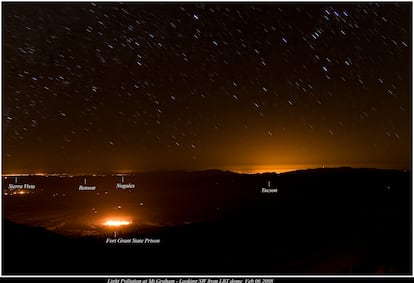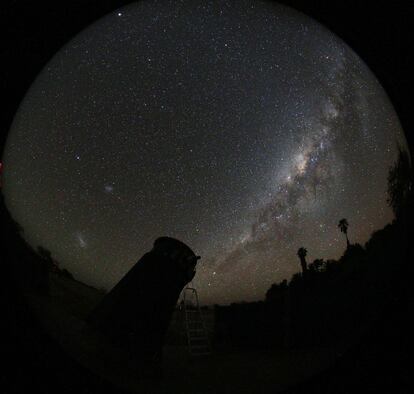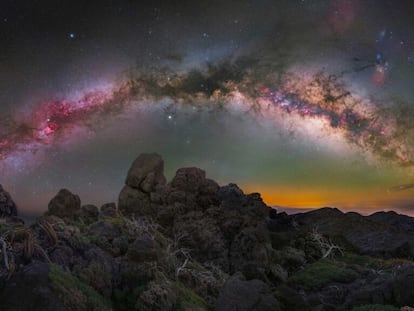Light pollution is weakening the world’s star-gazing telescopes
Artificial illumination is so bright now that astronomical observatories can no longer see celestial objects clearly

For centuries, astronomical observatories were located in cities. Astronomers looked at the stars from the centers of Berlin, London and Madrid. But when electric light came to the cities, the observatories had to move to the suburbs. They kept getting pushed further and further, and higher and higher. Now the functioning observatories of Europe and the United States are found on mountain peaks like Calar Alto (southern Spain) and Roque de los Muchachos (in Spain’s Canary Islands). But even that is not enough to shield them from light pollution. A recent study of the night skies over the world’s main observatories showed that most have so much artificial light nearby that it’s blinding their telescopes.
The study by scientists from Chile, Italy and Spain used data collected by all the satellites that make nightly passes over observatories hosting telescopes with apertures larger than three meters. Recently published in the journal of the British Royal Astronomical Society, the study found that only seven of the 28 observatories have a night sky brightness at zenith below 1% of the natural zenith sky brightness. Zenith sky brightness (directly above the observatory) is the principal measure of the amount of light pollution in the night sky. The study also considered other measures, such as the average brightness over the entire celestial hemisphere and the light at 30º above the horizon (the lowest angle at which most telescopes can operate). The horizon is the area where the most light pollution is found. Only one observatory in Namibia can be considered free of light pollution when the horizon measure is the only parameter used.
When the night sky is bright, collecting high-quality astronomical data requires more time and work. It’s as if the telescope shrinksFabio Falchi, Light Pollution Science and Technology Institute (Italy)
Fabio Falchi, a researcher with the University of Santiago de Compostela (Spain) and the Light Pollution Science and Technology Institute (Italy) was the lead author of the study. Falchi says light pollution is a relative concept because the reference point is the degree of darkness in a natural environment. “The night sky over Madrid is 40 times brighter than the natural sky,” said Falchi, who explains that observatories become less effective with so much brightness. “When the night sky is bright, collecting high-quality astronomical data requires more time and work. It’s as if the telescope shrinks. So even if you have a 12-meter telescope, it can only function like a nine- or eight-meter telescope.”
The best place to observe the stars is in the Namibian desert, where amateur astronomers set up an observatory as a tourist attraction at the Tivoli Southern Sky Guest Farm. Some of the best professional observatories are located in southern Africa, the Amazon jungle and the Atacama Desert in Chile. The three lowest-rated observatories are Chapultepec (Mexico), Pulkovo (Russia) and Mount Wilson (USA). They are all more than a century old and were once situated in ideal locations outside cities, but not too far away. But as Mexico City, St. Petersburg and Los Angeles grew, so did the light pollution, and these observatories were no longer viable, like many others in continental Europe and the United States.
Alicia Pelegrina, who works with the sky quality unit at the Andalusia Institute of Astrophysics (Spain), said, “Light is a messenger from celestial bodies, but if the sky isn’t dark, we can only see the brightest objects.” She says this is why “… astronomers were the first to warn the world about light pollution, which is environmental problem equal to hydrocarbons.” Pelegrina recently published a book about the harm that artificial light is doing to the sky, but also to humans and other life on Earth.

Light pollution is a byproduct of human technological advancement, says Pelegrina, who gives the example of the astronomical observatory in Granada (Spain). It was built by the Jesuits in the early 20th century in La Cartuja, located on the outskirts of the city. But they had to move it in 1968 to a Sierra Nevada mountain, and again in 1981 to an even higher location at the top of Veleta, the third highest mountain in the Iberian Peninsula. “We associate light with positive things like progress and advancement, but we have to change the paradigm now,” said Pelegrina.
University of Exeter (England) researcher Alejandro Sánchez has been studying and writing about light pollution for years. His most recent work revealed that the artificial light humans create is increasing, not dropping. “The minimum nighttime brightness around the world has increased by 49% since 1992,” said Sánchez, who explained that the word “minimum” is used because the data collection satellites they used in the study are blind to blue light. This is spectrum range for the vast majority of LED lights that are rapidly replacing all the other light bulbs in use around the world. Another study used data from the International Space Station, which has instruments that are able to record different light spectrums. It found an 11% increase in green spectrum light pollution, and a 24.4% increase in the blue spectrum between 2012 and 2020. Sánchez says that in Europe and the United States, this increase is due to a misguided preference for blue LED light instead of the more natural amber light. Improved living conditions in dense population centers like India and China have also led to more light pollution.
Lastly, the world’s artificial satellites are another source of light pollution. “They fill the sky with light when it’s dark on Earth, but up there the sun is shining on them,” said Sánchez. They’re like mirrors, reflecting sunlight and illuminating everything around. “And Elon Musk wants to put another 30,000 satellites in orbit!” exclaimed Sánchez. Not even the observatories in the deserts of Chile and Namibia will be able to escape.
Sign up for our weekly newsletter to get more English-language news coverage from EL PAÍS USA Edition
Tu suscripción se está usando en otro dispositivo
¿Quieres añadir otro usuario a tu suscripción?
Si continúas leyendo en este dispositivo, no se podrá leer en el otro.
FlechaTu suscripción se está usando en otro dispositivo y solo puedes acceder a EL PAÍS desde un dispositivo a la vez.
Si quieres compartir tu cuenta, cambia tu suscripción a la modalidad Premium, así podrás añadir otro usuario. Cada uno accederá con su propia cuenta de email, lo que os permitirá personalizar vuestra experiencia en EL PAÍS.
¿Tienes una suscripción de empresa? Accede aquí para contratar más cuentas.
En el caso de no saber quién está usando tu cuenta, te recomendamos cambiar tu contraseña aquí.
Si decides continuar compartiendo tu cuenta, este mensaje se mostrará en tu dispositivo y en el de la otra persona que está usando tu cuenta de forma indefinida, afectando a tu experiencia de lectura. Puedes consultar aquí los términos y condiciones de la suscripción digital.











































